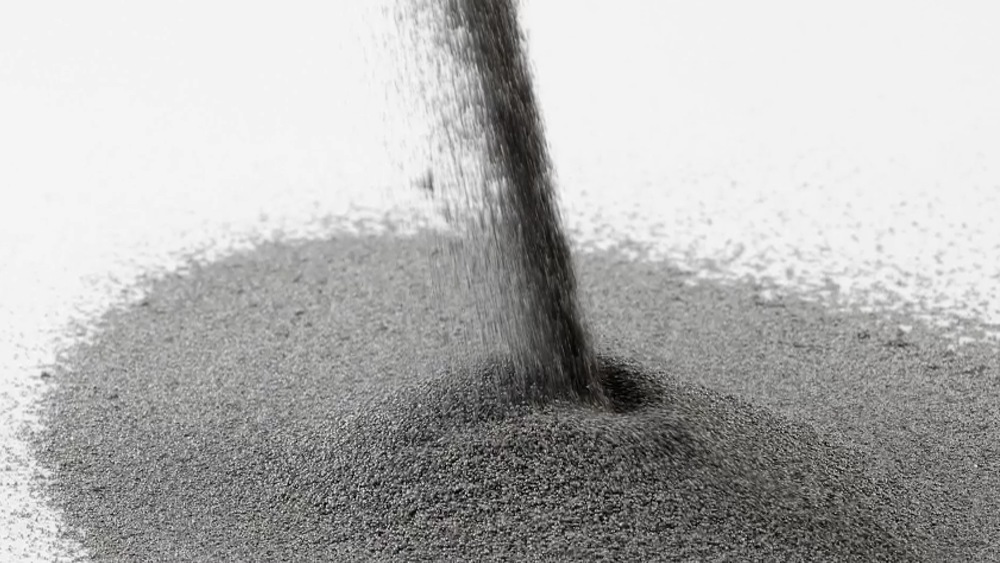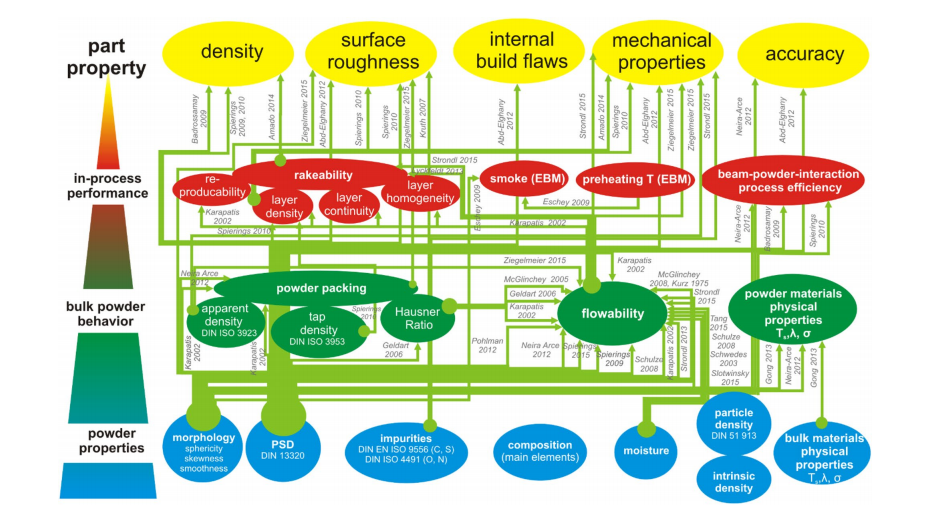
(Photo Credit: NanoSteel)
Metal 3D printing is becoming a vital source of production for a wide range of industries today, and a unique underrstanding of the required materials continues to grow around it. To sift through the finer details of powder usage, German scientists Silvia Vock, Burghardt Klöden, Alexander Kirchner, Thomas Weißgärber, and Bernd Kieback reviewed current testing and evaluating methods in ‘Powders for powder bed fusion: a review.’
While there are numerous different categories for using powder in additive manufacturing, powder bed fusion is the main process considered in their paper. Consequent powder properties can be subdivided, beginning at the lowest level with individual properties, in bulk, and then regarding how it behaves under certain conditions (in-process performance). Testing powders on the single particle scale is a standard, inexpensive exercise, while evaluating bulk-particle behavior and in-process performance are more difficult.
As the research team began reviewing powders for suitability, they discussed flowability first, looking at how unique powders behave once they are put into a manufacturing process and possibly under pressure of different sorts. Flowability is interconnected with equipment and the actual processes underway. The researchers also remind us that even the smallest variation in powder could have a substantial effect on processability. Testing techniques such as the Hall flowmeter funnel (ASTM B213) and the Carney funnel (ASTM B964) are used, however, the researchers do not hold much stock in funnel tests, unless the materials are ‘superior flowing powders.’ Although ‘cohesive powders’ may be suitable for use, they are not easily tested with funnel tests either.

Schematic visualization of the connection between the terms “flowability” and “flow properties” and respective parameters. (Image: ‘Powders for powder bed fusion: a review’)
Other tests such as the Hausner ratio (HR) are found to be unsuitable also, as well as Round Robin testing, and angle of repose. The most promising manner for testing flowability is powder testing with a powder rheometer; however, the researchers state that more studies are needed. Particle size distribution is a property not dependent on other parameters, but the team points out that ‘several issues and limitations can occur.’ For good flow, the PSD must be narrow and for a bulkier density, there must be wide distribution.
“From the large amount of observed correlations between PSD and other process relevant aspects as well as final part quality reviewed above, it is clear that PSD is an important powder characteristic and has to be carefully tailored,” states the research team. “However, it is not a parameter which can be used without additional information to decide how the powder will behave in the process.”
Final part quality investigations have been uncommon so far, but the researchers note the obvious connection regarding issues such as morphology, impurities, moisture content, particle density, and bulk material properties.
“It can already be seen that contradictions can occur both, for one interconnection between part and powder property, as well as between powder property and different part quality aspects. While in the first case the reason of the contradiction has a methodological reason, the second case is a sign for the need of optimization to tailor the final part quality to fit the requirements,” states the research team.
Studying powder for measures of suitability in metal 3D printing is not only vital to successful production, but such determinations will help to continue expanding the availability of applicable materials. Manufacturers can work on more optimal powders and target larger markets, while users enjoy new and improved materials.
“For a more precise identification of crucial powder and bulk properties, the solution will be either a combination of various characterization methods for given process parameters or a more complex powder characterization technique exclusively designed for the specific PBF process,” concludes the research team.

Visualization of the relationships between powder properties, bulk powder behavior, powder performance in process and finally the manufactured part quality as elaborated by different research groups (Image: ‘Powders for powder bed fusion: a review’)
What do you think of this news? Let us know your thoughts! Check out some of our other stories on 3D printing with metal, as it is featured in scenarios like Navy warships, presented as complex AM processes for other countries, and becoming important in applications like aerospace. Join the discussion of this article and other 3D printing topics at 3DPrintBoard.com.
[Source: Powders for Powder Bed Fusion: A Review]Subscribe to Our Email Newsletter
Stay up-to-date on all the latest news from the 3D printing industry and receive information and offers from third party vendors.
You May Also Like
Gorilla Sports GE’s First 3D Printed Titanium Cast
How do you help a gorilla with a broken arm? Sounds like the start of a bad joke a zookeeper might tell, but it’s an actual dilemma recently faced by...
Nylon 3D Printed Parts Made More Functional with Coatings & Colors
Parts 3D printed from polyamide (PA, Nylon) 12 using powder bed fusion (PBF) are a mainstay in the additive manufacturing (AM) industry. While post-finishing processes have improved the porosity of...
$25M to Back Sintavia’s Largest Expansion of Metal 3D Printing Capacity Since 2019
Sintavia, the digital manufacturing company specializing in mission-critical parts for strategic sectors, announced a $25 million investment to increase its production capacity, the largest expansion to its operations since 2019....
Velo3D Initiates Public Offering in a Bid to Strengthen Financial Foundations and Drive Future Growth
Velo3D (NYSE: VLD) has been among a number of publicly traded 3D printing firms that have attempted to weather the current macroeconomic climate. After posting a challenging financial report for 2023,...































